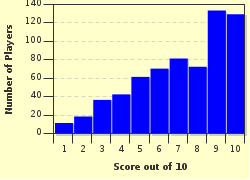Quiz Answer Key and Fun Facts
1. The word "kinetic" comes from the Greek word, "kinetikos", which means moving. The kinetic theory of matter consists of three assumptions. Which of the following is NOT one of them?
2. Boiling and melting require heat absorption. On the other hand, condensation and freezing release heat to the surroundings. Sublimation is the change of state either from solid to gas or from gas to solid. It is a special process where it only happens in some matter, for example, iodine, dry ice (solid carbon dioxide) and naphthalene. You notice that during a process, iodine crystal changes into gaseous state. Is heat being absorbed by the crystal or released to the environment?
3. The three basic subatomic particles are proton, neutron and electron. Which one is the lightest?
4. Both protons and neutrons are located in the nucleus. On the other hand, electrons orbit in the electron shells around the nucleus.
5. The proton number is the number of protons of an atom. For example, the proton number of a carbon atom is 6, which corresponds to its 6 protons. On the contrary, the nucleon number is the sum of the number of neutrons and the number of protons of an atom. Which of the following atoms has the same value for its proton number and nucleon number?
6. A new element has been found by scientists and it has been determined that the proton number and the nucleon number for this element is 100 and 198 respectively. What is the number of neutrons of this element?
7. Atoms of the same element which have the same proton number but different nucleon number are called isotopes. Which two of the four atoms below are isotopes?
Atom A: 10 protons, 10 neutrons, 10 electrons.
Atom B: 10 protons, 10 neutrons, 11 electrons.
Atom C: 10 protons, 11 neutrons, 10 electrons.
Atom D: 11 protons, 10 neutrons, 10 electrons.
8. Dimitri Mendeleev, a Russian chemist arranged the position of elements in the periodic table in order of increasing atomic weight. However, it was Henry Moseley who made great contribution towards the periodic table of chemical elements that we use nowadays. He refined the periodic table by arranging the elements according to the number of ______.
9. The periodic table of chemical elements is further divided into 7 periods and 18 groups. What is the significance of this classification?
10. Metals are grouped on the left hand side of the periodic table of chemical elements. Meanwhile, non-metals are located on the right hand side. On the other hand, metalloids are located between these two groups of elements. Which of the following is a metalloid?
Source: Author
Matthew_07
This quiz was reviewed by FunTrivia editor
crisw before going online.
Any errors found in FunTrivia content are routinely corrected through our feedback system.

